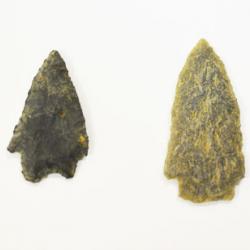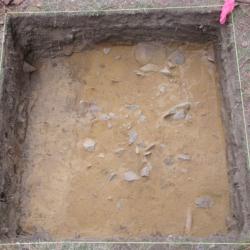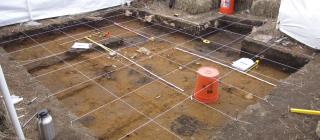The Million Dollar Beach Site was identified in August of 2013 during a survey of the area around the DEC parking lot and campground prior to road improvements (see Photo 1). This survey proceeded directly into limited test excavations after the discovery of almost 2,000 prehistoric artifacts and diagnostic material culture related to the Early Archaic (8,000-6,000 BC) and Late Archaic (4,000-1,500 BC) Periods as well as some artifacts and a lime kiln associated with historic Fort George. The site is concentrated around the road and its northern border extends from underneath the beach parking lot, through the median between the lot and the road, underneath the road itself, and into the camp ground. The highest density of material has been identified in the areas closest to the road but a lower density scatter was noted for the majority of the campground area and into wooded areas surrounding it. Overall, it encompasses at least several acres.
A diverse array of artifacts was recovered including 28 whole and broken bifaces, 11 whole and broken projectile points (i.e. Bifurcate, Genesee, Lamoka, and unidentified projectile points – see Photo 2), several spokeshaves, expedient utilized flakes, a drill, and a uniface. These artifacts are manufactured from a variety of materials including Onondaga, Normanskill, and Mt.Merino chert. In addition, quartzite, jasper, and argillite flakes have been recovered. Analysis of the survey and excavation work is ongoing but has so far has documented thousands more artifacts and has identified at least two possible workshop locations. These two potential lithic reduction workshop locations are both located near the road and have a very high density of flakes. One was identified during the survey and a single shovel test into it produced over 1,000 pieces of debitage. The second (see Photo 3), was exposed during the test excavations and a significant goal of the next phase of work will be to horizontally expose more of this feature to map and document it in greater detail. Both concentrations seem to be comprised primarily of a local chert available only a few hundred feet away in the side of Fort George Hill but future visual and (X-ray Fluorescence) XRF analyses will help to determine if this is true or not.
The initial phase of work was wrapped up in November of 2013 with plans made to return in late Winter or very early Spring of 2014 to complete work in several high density areas within the park.
Please check back in the future for additional updates on this work!








